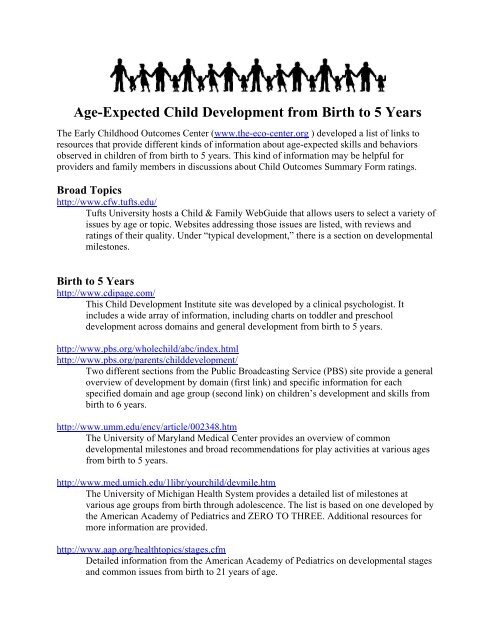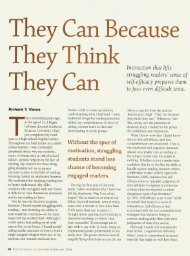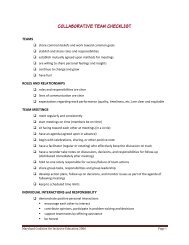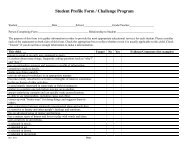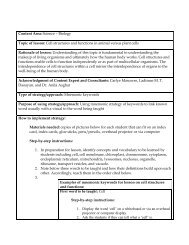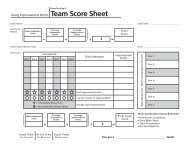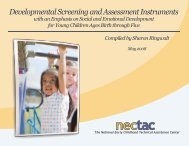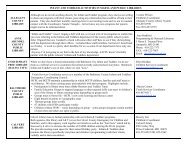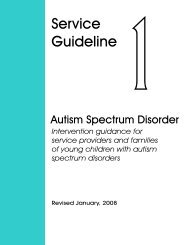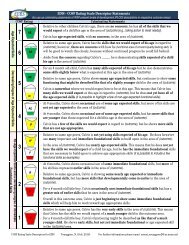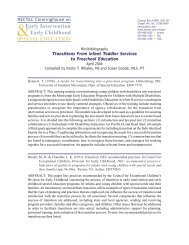Age-Expected Child Development from Birth to 5 Years - Mass.Gov
Age-Expected Child Development from Birth to 5 Years - Mass.Gov
Age-Expected Child Development from Birth to 5 Years - Mass.Gov
You also want an ePaper? Increase the reach of your titles
YUMPU automatically turns print PDFs into web optimized ePapers that Google loves.
<strong>Age</strong>-<strong>Expected</strong> <strong>Child</strong> <strong>Development</strong> <strong>from</strong> <strong>Birth</strong> <strong>to</strong> 5 <strong>Years</strong><br />
The Early <strong>Child</strong>hood Outcomes Center (www.the-eco-center.org ) developed a list of links <strong>to</strong><br />
resources that provide different kinds of information about age-expected skills and behaviors<br />
observed in children of <strong>from</strong> birth <strong>to</strong> 5 years. This kind of information may be helpful for<br />
providers and family members in discussions about <strong>Child</strong> Outcomes Summary Form ratings.<br />
Broad Topics<br />
http://www.cfw.tufts.edu/<br />
Tufts University hosts a <strong>Child</strong> & Family WebGuide that allows users <strong>to</strong> select a variety of<br />
issues by age or <strong>to</strong>pic. Websites addressing those issues are listed, with reviews and<br />
ratings of their quality. Under “typical development,” there is a section on developmental<br />
miles<strong>to</strong>nes.<br />
<strong>Birth</strong> <strong>to</strong> 5 <strong>Years</strong><br />
http://www.cdipage.com/<br />
This <strong>Child</strong> <strong>Development</strong> Institute site was developed by a clinical psychologist. It<br />
includes a wide array of information, including charts on <strong>to</strong>ddler and preschool<br />
development across domains and general development <strong>from</strong> birth <strong>to</strong> 5 years.<br />
http://www.pbs.org/wholechild/abc/index.html<br />
http://www.pbs.org/parents/childdevelopment/<br />
Two different sections <strong>from</strong> the Public Broadcasting Service (PBS) site provide a general<br />
overview of development by domain (first link) and specific information for each<br />
specified domain and age group (second link) on children’s development and skills <strong>from</strong><br />
birth <strong>to</strong> 6 years.<br />
http://www.umm.edu/ency/article/002348.htm<br />
The University of Maryland Medical Center provides an overview of common<br />
developmental miles<strong>to</strong>nes and broad recommendations for play activities at various ages<br />
<strong>from</strong> birth <strong>to</strong> 5 years.<br />
http://www.med.umich.edu/1libr/yourchild/devmile.htm<br />
The University of Michigan Health System provides a detailed list of miles<strong>to</strong>nes at<br />
various age groups <strong>from</strong> birth through adolescence. The list is based on one developed by<br />
the American Academy of Pediatrics and ZERO TO THREE. Additional resources for<br />
more information are provided.<br />
http://www.aap.org/health<strong>to</strong>pics/stages.cfm<br />
Detailed information <strong>from</strong> the American Academy of Pediatrics on developmental stages<br />
and common issues <strong>from</strong> birth <strong>to</strong> 21 years of age.
<strong>Birth</strong> <strong>to</strong> 5 <strong>Years</strong> (continued)<br />
http://www.cdc.gov/ncbddd/autism/actearly/default.htm<br />
This information <strong>from</strong> the Centers for Disease Control and Prevention (CDC) provides<br />
bulleted information on the developmental miles<strong>to</strong>nes for children <strong>from</strong> 3 months <strong>to</strong> 5<br />
years of age and offers developmental warning signs for each age group. The site also<br />
offers interactive <strong>to</strong>ols for users <strong>to</strong> specify certain ages, select areas of development, and<br />
examine expected changes in miles<strong>to</strong>nes over time.<br />
http://www.kidsgrowth.com/stages/guide/index.cfm<br />
This site provides brief paragraphs summarizing what is commonly observed at various<br />
ages <strong>from</strong> birth <strong>to</strong> 18 years. It includes bulleted descriptions of specific skills in many<br />
areas, including development and feeding behavior. The site also provides considerable<br />
parenting resources and advice, with content overseen by a medical advisory board.<br />
http://www.babycenter.com/baby/babydevelopment/index<br />
This site provides information on development and key issues by age (birth <strong>to</strong> 8 years).<br />
Miles<strong>to</strong>ne charts and common questions/issues and resources are provided for each age. In<br />
many cases, miles<strong>to</strong>ne charts are organized by skills that most kids this age can do,<br />
emerging skills that about half of kids this age can do, and advanced skills that a few kids<br />
this age can do. There also is a section on what <strong>to</strong> expect when, with a list of common<br />
questions <strong>from</strong> parents about their children’s development. Considerable information is<br />
provided about warning signs for developmental delays.<br />
http://www.talaris.org/timeline.htm<br />
This site provides a timeline of development of skills in children birth <strong>to</strong> 5 years, with<br />
references for further information. It also provides “Research Spotlights,” many of which<br />
combine 60-second video spots with information on key parenting issues and related<br />
<strong>to</strong>pics.<br />
http://ohioline.osu.edu/hyg-fact/5000/5297.html<br />
This site includes a short fact sheet about differences in children’s play at various ages.<br />
http://www.speechdelay.com/testrosemiles<strong>to</strong>nes1.htm#0-6%20MONTHS<br />
This site was developed by a speech therapist. It identifies speech miles<strong>to</strong>nes <strong>from</strong> birth <strong>to</strong><br />
7 years and provides “Talking Tips” <strong>to</strong> teach parents how <strong>to</strong> support language<br />
development.<br />
http://www.nidcd.nih.gov/health/voice/speechandlanguage.asp#mychild<br />
This site by the National Institute on Deafness and Other Communication Disorders<br />
provides an interactive checklist for users <strong>to</strong> check off a child’s skills and track<br />
development <strong>from</strong> birth <strong>to</strong> 5 years. Additional information about ongoing research is also<br />
presented.<br />
http://en.wikipedia.org/wiki/<strong>Child</strong>_development<br />
Although this site requires the caveat that its content is open <strong>to</strong> editing and addition by the<br />
general public, Wikipedia content generally has been found <strong>to</strong> be quite consistent with<br />
other sources. The site includes a detailed description of common patterns of child<br />
development across domains <strong>from</strong> birth <strong>to</strong> 5 years.
<strong>Birth</strong> <strong>to</strong> 3 <strong>Years</strong><br />
http://www.firstsigns.org/healthydev/healthydev.htm<br />
This site provides questions and information about warning signs suggesting that a child’s<br />
development may be exhibiting some delays relative <strong>to</strong> more typical miles<strong>to</strong>nes. Articles,<br />
checklists, and steps <strong>to</strong> take are provided.<br />
http://health.discovery.com/centers/kids/timeline/timeline.html<br />
Information <strong>from</strong> the Discovery Health Channel offers basic developmental miles<strong>to</strong>ne<br />
information for children birth <strong>to</strong> 1 year old.


